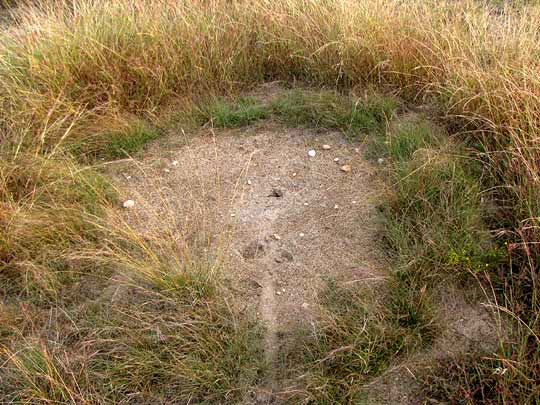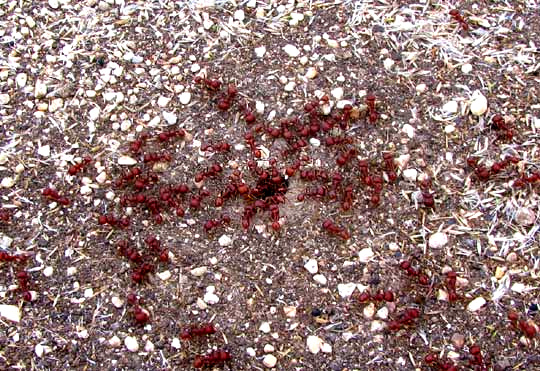Excerpts from Jim Conrad's
Naturalist Newsletter
from the November 17, 2013 Newsletter issued from the Frio Canyon Nature Education Center in the valley of the Dry Frio River in northern Uvalde County, southwestern Texas, on the southern border of the Edwards Plateau; elevation ~1750m (~5750 ft); N29.62°, W99.86°; USA
RED HARVESTER ANTS
A common and conspicuous feature of our local landscape is a spot of bare ground about the size of a small bathroom surrounded by normal vegetation, with a single hole in the center of the bare ground wide enough to poke a finger into. You find these in the middle of seldom used gravel roads, abandoned lots, lawns, city parks, in pastures, grassy areas along cliffs -- just about any open, dry area. Below you can see such a barren spot in the middle of a large field of invasive King Ranch Bluestem near Juniper House:

This is the entrance to a colony of harvester ants. You can see the large (¼-inch, 6mm), reddish ants entering and leaving the hole below:

In that picture notice that a little away from the hole the ground is littered with husks of grass grains and other dry plant material. A close-up showing ants at the hole is shown below:

A close-up of an individual ant appears below:

One feature distinguishing this species from some others -- Bea in Ontario says that we have ten harvest ant species in Texas -- is the pair of small spines at the rear of the large body segment (thorax) immediately behind the head. We're assuming that this is the common species in our area, the Red Harvester Ant, POGONOMYRMEX BARBATUS.
As with most ant species, winged male and female harvester ants live in the nest until weather permits them to fly away and mate. After that, usually the male dies, but the newly-fertilized queen flies away and chooses a spot for her new colony. She sheds her wings, digs a hole and begins producing all-female "worker ants." She keeps at this for up to twenty years until her death; some queens have been known to live up to 30 years in the wild.
Workers forage around the nest for seeds, which they store in the nest's underground chambers. One nest has been reported to extend 15 feet deep (4.5m) and contain 436 chambers. Three to eight trails typically lead away from the mound. Scout ants are the first to leave the nest each morning. When they find food they mark their return path to the mound so that workers can follow the scout's scent to the food. Other worker ants clean, extend and generally tend to the mound, the queen and the brood.
If you've every had a commercially supplied ant farm there's a good chance that your ants were Red Harvester Ants, who are considered ideal for the purpose because of their large size, the interesting way they store seeds in chambers, as well as their inability to climb the farm's glass walls.
Though folks around here don't seem too concerned about their presence -- while photographing them I got them all over my body and camera without being stung or bitten -- I read that harvester ant workers of the genus Pogonomyrmex (ours) possess the most toxic venom to mice documented in any insect tested so far, comparable to cobra venom. Since we don't hear of people succumbing to harvester ant stings, the ants must rarely bite, and not inject much venom when they do.
Red Harvester Ants are found in the US Southwest, from Oklahoma, Kansas, New Mexico and Arizona south into Mexico.
entry from August 16, 2022, issued from near Tequisquiapan, elevation about 1,900m (6200 ft), Querétaro state, MÉXICO
SEED DISPERSAL BY ANTS

The above was encountered on a narrow, dusty, dirt road through scrub on an overgrazed, eroded, thin-soiled slope, where the rainy season is very late in coming and the whole landscape suffers from drought. In the picture, the brown mass at the left is a dried-up cow paddy, the white objects being mesquite seeds. The many small, spherical, brown and orange items are desiccated fruits from a Desert Hackberry about three meters away (10ft). This is exactly the kind of trail of small, dried fruits harvester ants leave. Harvester ant nests are abundant in this landscape, and ants could be followed from the location in the picture to a nest about 9m upslope (30ft). Here's one of the ants working on a fruit:

In the picture the ant is atop the fruit, apparently trying to remove the dried, hard flesh. In the pictured area, no ant was trying to move a fruit. The line of fruits ended at an ankle-high shelf of bedrock outcropping in their path upslope. Only very few dried fruits had made it over that shelf, and ants were trying to move them toward the nest, albeit with no success I could see, as shown below:

My best guess is that the ant is the Red Harvester Ant, Pogonomyrmex barbatus, distributed from arid Arizona east to Oklahoma and Texas, south in the arid uplands of Mexico to Oaxaca. In the past I've seen such trails of dried, seed-bearing segments of mesquite pods.